 21
March
2022
21
March
2022
ISET Economist Blog
 Wednesday,
19
April,
2023
Wednesday,
19
April,
2023

 Wednesday,
19
April,
2023
Wednesday,
19
April,
2023
(3-minute read)
Under the Georgian Constitution, the country's strategic objective is to join the European Union. The vast majority of citizens agree with and support this objective. The European future is not only the country's historical strategic choice but also the hope for the prosperity and well-being of the country's population and the promise of a better future for future generations.
The scholarly literature and statistics suggest that countries that join the European Union economically progress as a result of convergence with the EU’s robust economic, regulatory, and institutional system and that the quality of life in these new member states substantially improves. Currently, there is a large gap between the socioeconomic well-being of the Georgian population and that of the European Union, and this indicates the opportunity that will open to the Georgian population as a result of its integration with the EU. What specific economic and social benefits Georgians can anticipate from the European future? To respond to this question, we performed the following:
We provide subject analysis below. In terms of various socioeconomic indicators of the population, there is a vast gap between the European Union and Georgia, and EU integration will offer the conditions for the country to close this gap quickly and effectively. The analysis of seven important socioeconomic indicators for the period 2004-2021 demonstrates that the countries of the 2004 EU enlargement significantly and swiftly improved the well-being of the population in terms of decreased unemployment, decreased poverty, increased average pension, decreased traffic-related death rate, decreased CO2 emissions to the atmosphere, and improvement of air quality. Compared to these countries, Georgia has made relatively insignificant progress. According to the comparison model, if Georgia were to develop at the same rate as the integration with European space, standards, and achievements brought to the countries of the 2004 enlargement, the unemployment rate would be 1,8 times lower than it is today, 3 times fewer citizens would be living below the poverty line, monthly pensions would be higher, households would be able to spend twice as much on recreation and culture, twice as fewer people would die annually in traffic accidents, CO2 emissions in the atmosphere would be reduced by two times, the concentration of PM2.5 in the air would be reduced by 40%, and mortality caused by air pollution would be reduced by 40%.
1.1. As of 2021, GDP per capita in the EU was approximately 665 % higher than in Georgia.
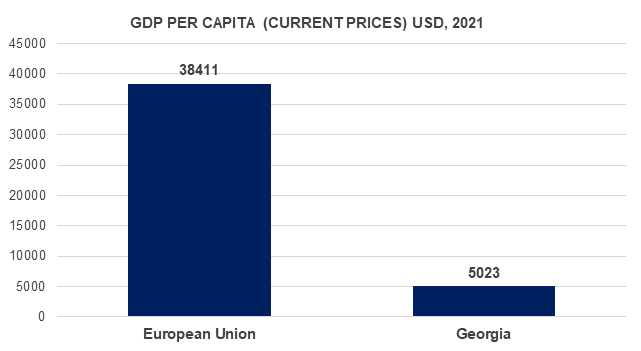
Source: World Development Indicators, World Bank
1.2. According to 2019 data, the average monthly income in the EU is 2,734 USD, which is 582% higher than the average monthly income in Georgia (400 USD equivalent).
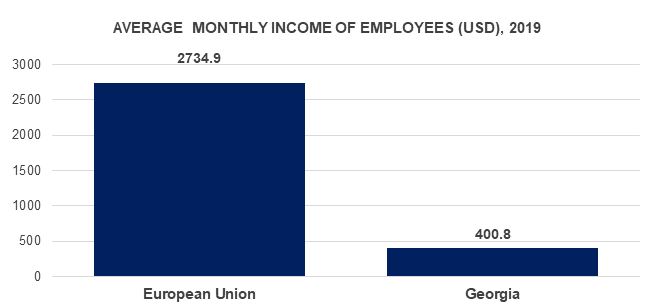
Source: ILOSTAT
1.3. According to 2021 data, the unemployment rate in Georgia is 3 times higher than in Georgia.
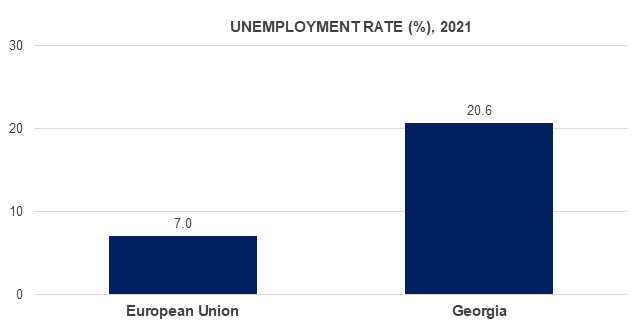
Source: World Development Indicators, World Bank, GeoStat.
1.4. The share of youth in Georgia who neither study nor work is double that of the EU.
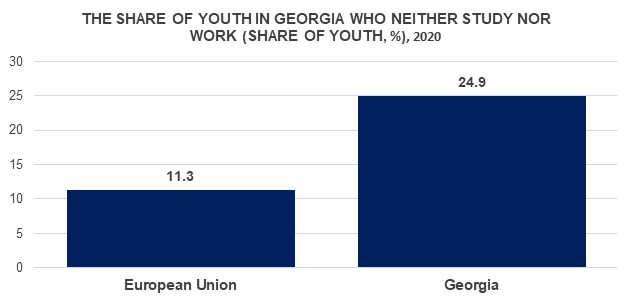
Source: World Development Indicators, World Bank, GeoStat
1.5. According to data from 2020, the average monthly pension in EU countries is 1201 euros, which is nearly 18 times greater than the pension in Georgia (64 euros).
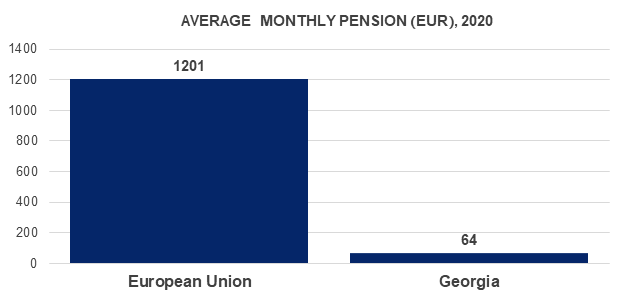
Source: Eurostat, GeoStat
1.6. In the disciplines of education and healthcare, the average monthly salary in the European Union is overwhelmingly higher than in Georgia. According to Eurostat 2018 and Geostat 2021 data, the average EU salary in the education sector is 11 times that of Georgia’s, while the average EU salary in the healthcare sector is 9 times that of Georgia.
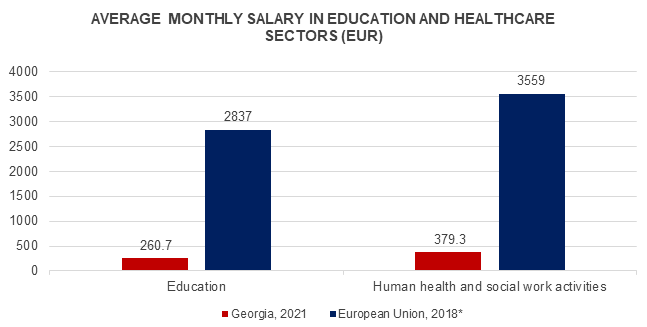
Source: Eurostat, GeoStat
1.7. According to data from 2020, the average life expectancy in the European Union is 80,5 years, which is 8 years longer than the average life expectancy in Georgia.
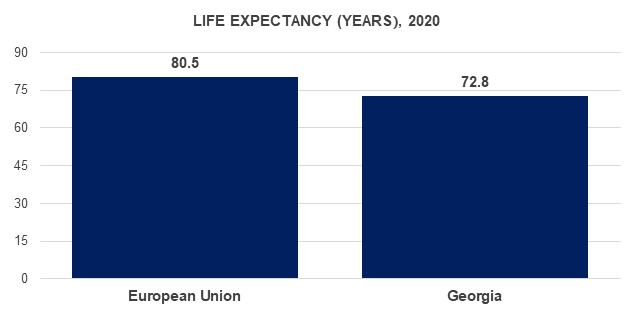
Source: World Development Indicators, World Bank
2.1. Unemployment Index
In 2004 EU enlargement countries and Georgia had unemployment rates that were quite similar. However, the ten EU entrant countries have had a noticeably favorable trend since 2004, with the unemployment rate having been reduced by half by 2021, while in Georgia, unemployment decreased by only 3 percent.
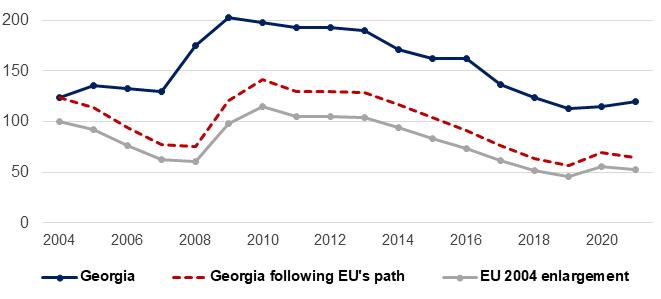
Source: World Development Indicators, World Bank, ILO Modeling Estimates
According to a model based on the tendencies of selected European Union countries, the number of unemployed in Georgia would have significantly decreased - by 85,567 between 2004 and 2021-.
2.2. Proportion of population below the poverty line (%, USD 3.65 per day, PPP, 2017).
In 2004, up to 3 % of the population in EU enlargement, 10 countries lived below the poverty line of $3.65 per day, compared to 33 % in Georgia. By 2019, this figure in selected EU countries decreased to 0.5%, while in Georgia this figure decreased only to 18%.
Using a model based on the trajectory of EU 2004 enlargement countries, the percentage of Georgians living below the poverty line would reduce from 18.5% in 2004 to 6% in 2019, which is three times better outcome compared to the current status.
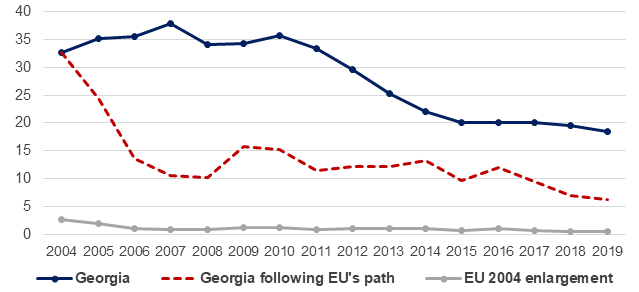
Source: World Development Indicators, World Bank
2.3. Average monthly pension
During 2014-2020, the average pension of the population above the statutory pensionable age in the 10 countries that joined the EU in 2004 increased by 20%. Despite the fact that pensions in Georgia have increased by 34% in GEL over the past few years, the average pension calculated in Euros has not increased.
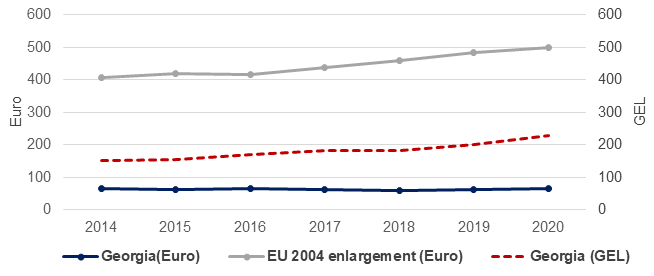
Source: GeoStat, Eurostat
2.4. Fatalities caused by road traffic accidents
In 2004 the EU entrant 10 countries and Georgia’s average figures on road traffic fatalities per 100,000 population were practically similar. Following their entry to the EU, these ten countries adopted high European standards of road safety, and road accident-related death rates fell by a factor of two or more, whereas Georgia's accomplishment has been limited. According to World Health Organization data, 496 people died in road traffic accidents in Georgia in 2019. According to a model based on the tendencies of selected EU countries from 2004 to 2019, the number of deaths in Georgia in 2019 would be 236 fewer, meaning that 236 could have been saved.
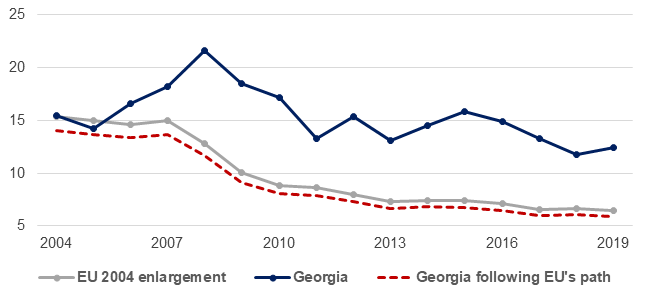
Source: World Development Indicators, World Bank
2.5. Household expenditures on recreation and culture (percentage of total expenditures)
Expenditure by households on recreation and culture is an important indicator of well-being. In the ten countries of 2004 EU enlargement, households spent approximately 8% of their monthly income on leisure and culture in 2021. In Georgia, this figure was only 1.2%. According to a model based on the tendencies of the EU2004 enlargement countries for the period 2017-2021, the proportion of family expenditures on recreation and culture in Georgia would double and increase to 2.5%.
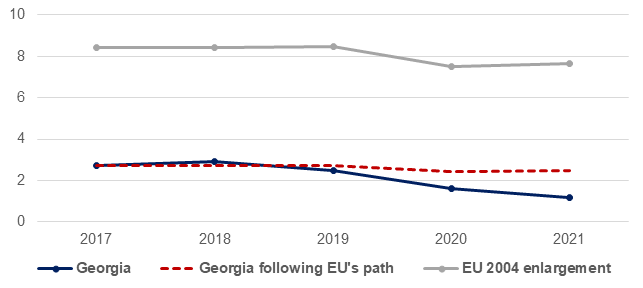
Source: Eurostat, Final consumption expenditure of households, by consumption purpose
Geostat, Households Incomes, and Expenditures Survey
2.6. CO2 emissions (kg per PPP $ of GDP)
In 2004, CO2 emissions per capita in EU 2004 ten enlargement countries were double those of Georgia. By 2019, these European countries have reduced this significantly – by 65 %, and after Georgia's insignificant reduction of 8%, the figures of these countries and Georgia became identical. According to a model that uses the 2004-2019 tendencies of EU 2004 enlargement countries, Georgia's CO2 emission rate would drop two-fold – to 0.7 kg per capita in 2019.
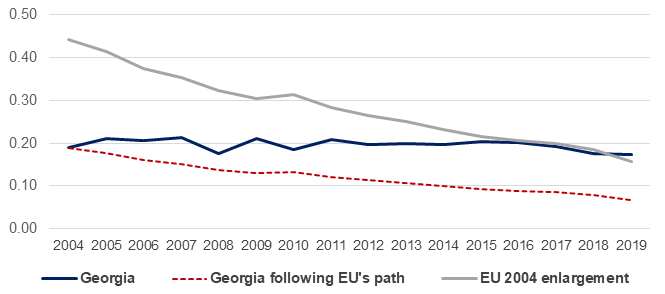
Source: World Development Indicators, World Bank
2.7. Air quality – average PM 2.5 exposure
Fine particle concentration (PM 2.5) is an additional indicator of air quality. Similar to CO2 emissions, Georgia had the lowest rate among the ten selected countries in 2004. Between 2004 and 2020, fine particle emissions in the EU 2004 enlargement countries decreased by 33%, while the level of air pollution in Georgia increased by 11%, reaching 17.3 g/m3. According to a model based on the tendencies of selected EU countries, the concentration of PM2.5 in the air would decrease to 10.5 g/m3, which would represent a 40% improvement.
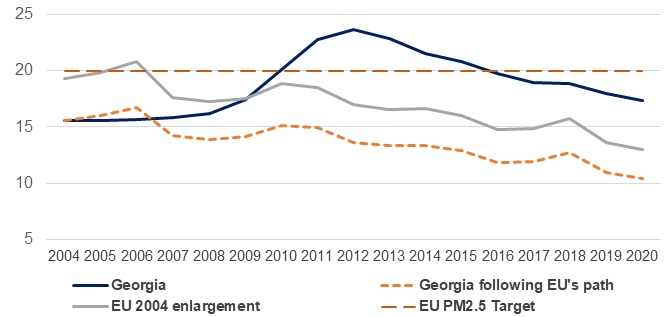
Source: OECD STATS
The annual PM2.5 standard imposed by the World Health Organization (WHO) is 5 μg/m³. In Georgia, the corresponding European Union standard has been adopted, which is less restrictive than WHO requirements. According to the EU standard, the annual permissible level for PM2.5 is equal to 20 µg/m³.
2.8. Ambient air pollution attributable death rate (per 100 000 population)
According to data from 2019, the death rate due to air pollution (per 100,000 population) in Georgia is three times higher than in 27 European countries and in 10 countries that joined the EU in 2004. In 2019 in Georgia 3,449 individuals died as a result of air pollution.
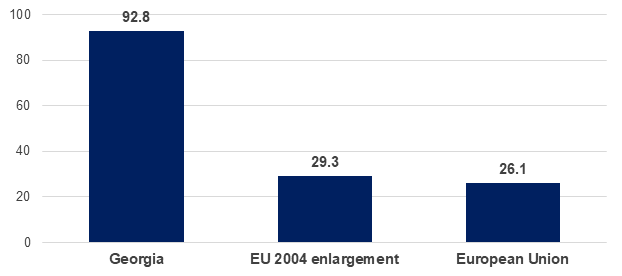
Source: The Global Health Observatory, WHO
2.9. Prevalence of tobacco use (percentage of the population aged 15 and older)
In 2005, the share of smokers in Georgia's population was lower than in the countries that joined the EU in 2004. By 2020, due to the fact that the percentage of smokers in Georgia hardly decreased while it decreased by 15% in the subject countries, by 2020 Georgia’s share of the smoker population became higher than that of those countries. In 2020, the total number of smokers in Georgia was 937,638. According to the model based on the tendencies of 2004 EU enlargement countries, this number would decrease by 124 thousand between 2005 and 2020.
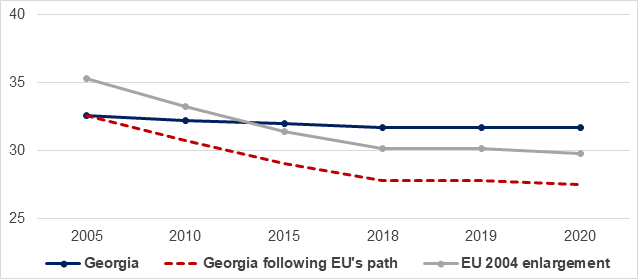
Source: World Development Indicators, World Bank
In summary, as the comparison and modeling of the selected socioeconomic characteristics indicated, Georgia has an opportunity to improve the well-being of its population by integrating with European high standards and the EU’s legal, institutional, and regulatory framework. This, among others, will result in a reduction in unemployment and poverty, an increase in average pay and pension, and a healthier living environment, thereby enhancing living conditions and life expectancy.





